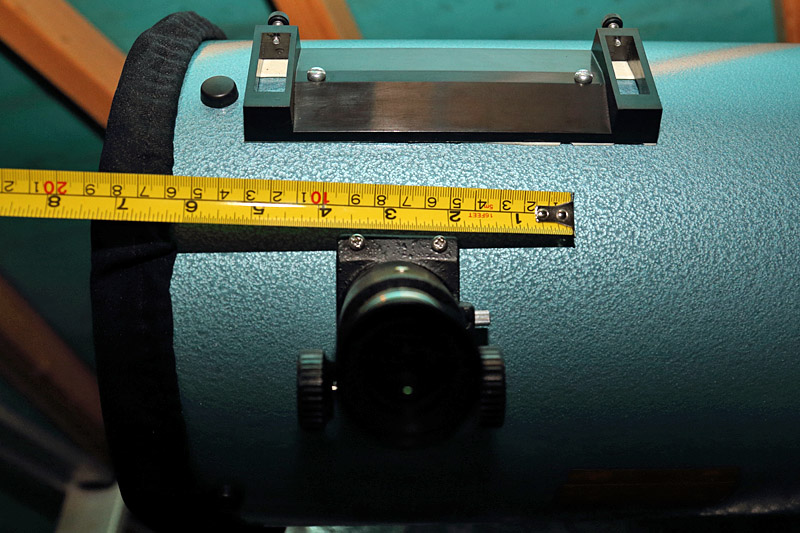A day of intermittent heavy rain and thunder gave way to clear skies during the evening, for once exactly as the forecast had predicted. The BBC and Metcheck’s forecasts both agreed, which seems to be a rare event in itself, so as it got dark I went and unlocked the observatory (I like the sound of that!) and pulled the scope out.
Earlier in the evening I had been in a pretty awful mood, no reason just a bad day, and felt more like saying ‘sod it’ and going to bed but I am very glad I didn’t as the sky turned out to be magnificent.
All too often when you step outside and look up, what looks promising at first often proves to be pretty average, even poor, but not last night. After getting dark adapted, I checked the naked eye limiting magnitude, using charts of Ursa Minor and Cygnus, and it was better than 6.5! We have pretty dark skies here, but better than 6.5 is fairly rare. Usually we get between 6.0 and 6.5 but last night was as good as 6.7! I would guess that the heavy rain and thunder had cleared the atmosphere of pollutants and dust. During my trips to the TSP, I’ve seen people using ‘iridescence’ in the Milky Way to gauge transparency – the more iridescent the MW, the more transparent the sky. The Milky Way was just like that here last night, iridescent, which we rarely see because of summer haze. Visible to the unaided eye were M13, M31 (later on when clear of the trees) and NGC 7000, the North America Nebula These were truly great summer observing conditions and well worth the long wait for.
Conditions: Clear, quite chilly
Seeing: Very good: Ant II
Transparency: Excellent – I, but a few odd bits of drifting cloud later on
NELM: 6.5-6.7, dropping slightly when the waning crescent Moon rose later on
First was Aquila and a hunt for the few Herschel 400 objects (three) that are here:
NGC 6781, planetary Nebula in Aquila – Set in nice starry field this is large and oval and quite bright. It’s easily seen without a filter but my OIII brings it out nicely. With the OIII, the pn looks slightly rounder with some darkening in the centre, without the filter I can’t see the darkening very well. Very nice object. 69x, 101x + OIII
NGC 6755, open cluster in Aquila – An attractive, small, compressed cluster set in a nice Milky Way field. Stars all white and evenly bright. Found at 69x as a misty knot, detached from MW star field.
101x shows a tiny, vaguely triangular clump of stars, with around a dozen or so on a hazy background and with a fainter patch next to it but at 138x, the cluster looks like a butterfly with the left wing richer than the right one. Very pretty! 69x, 101x, 138x
NGC 6756, open cluster in Aquila – Next to NGC 6755 in the field of view of the 22mm Panoptic (69x). It’s half a dozen stars on a misty background. Not as rich or as compressed as its neighbour. Framed by a bight star at either end. 69x, 101x, 138x
I saw on my star charts that the globular cluster Palomar 11, also in Aquila, was nearby, and given the excellent conditions I decided to have a crack at seeing it. After quite a few false starts I eventually found it. It’s in quite a rich area and nailing it down was a bit hard. It appears as a roundish brightening of the sky. Its low surface brightness and location in quite a rich part of the sky made finding it difficult but I caught it eventually. The observation of the night, I think. 69x, 101x, 138x, 190x
I also decided to see if I could see ICs 59 and 63 in Cassiopeia. Given the great night it would have been a shame not to go for the faint stuff.
IC 59, IC 63, diffuse nebulae in Cassiopeia – These faint little buggers are right next to Gamma Cas, so it’s necessary to put that out of the field of view before attempting to look for them. IC 59 is a faint fan-shaped patch while IC 63 is fainter still – in fact I barely saw 63, just a mere brightening in the area. 69x + UHC filter.
M31, galaxy in Andromeda – this lovely piece of eye candy is one of my favourites to look at and I always drop in to say ‘hi’ when I am observing and M31 is high enough. Last night’s conditions gave me the best telescopic view I have ever had of this galaxy. Under average skies usually only the bright central area is visible but last night, I could see (using my big 35mm Panoptic, at 43x) the galactic disk spreading out across and beyond the field of view, and the dust lanes. It was spectacular, to say the least.
NGC 6229, globular cluster in Hercules – Very bright and easy to find (made a nice change from Pal 11 and the faint nebulae in Cassiopeia!). Small and round with a dense core at 69x.
At 138x, it began to look granular with some stars resolved, especially the outer ones.
At 190x, individual stars can be seen and the halo and core are very bright, still looked granular across the face. 69x, 138x, 190x.
NGC 6207, galaxy in Hercules – bright and easily seen at 69x. It is completely overshadowed by its big and bright famous neighbour, M13. Oval, with a brighter core. Elongated northeast-southwest. 69x, 101x
I also popped over to see the big showy eye candy neighbour, which was absolutely superb as usual and in the same field they make a nice pair, with the galaxy being a hidden treasure.
Before packing in, I dropped in on Jupiter, which was shining like a big searchlight in the eastern sky, as the seeing was so good, and it looked decidedly odd without the South Equatorial Belt, which has totally faded away.
By 0200, the waning crescent Moon was substantially interfering with the sky conditions and there was more drifting cloud around so that, along with the fact my feet were by now very cold (I was wearing thin trainers) made packing up a Very Good Idea. So did the prospect of work in a few hours. So within five minutes, I’d pulled the scope back into the shed, chucked my charts back in their box, gathered up my eyepieces, locked up and headed back to the house.
As mentioned in my previous post, I’d found that the addition of wheels made my scope eyepiece higher off the ground. I knew it would be higher but not *how* higher. Consequently, viewing stuff at the zenith required standing on tiptoes. This was awkward and uncomfortable, as it hurt my calf muscles and toes, so some sort of small stool was a must. I found a little plastic step stool in Tesco this afternoon, for £2.50, which will fit the bill nicely.







